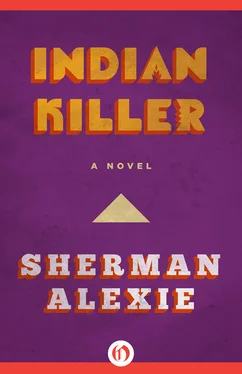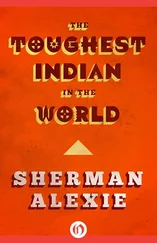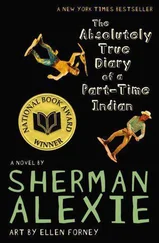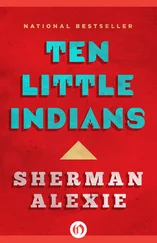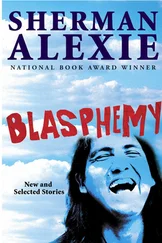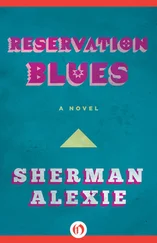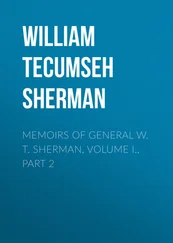“THE INDIAN KILLER,” BEGAN Dr. Mather, “is an inevitable creation of capitalism. A capitalistic society will necessarily create an underclass of powerless workers and an overclass of powerful elite. As the economic and social distance between the worker and elite increases, the possibility of an underclass revolution increases proportionally. The Indian Killer is, in fact, a revolutionary construct.”
Dr. Mather was wearing a huge bandage on his forehead. A few of the students wondered aloud if he’d been attacked by the Indian Killer, but Marie Polatkin knew that wasn’t true. None of them knew that Mather had knocked himself silly by running into a low overhang in the Anthropology Building basement.
“The kidnapping of Mark Jones is actually a bold, albeit cowardly, metaphor for the Indian condition. Indian people have had their culture, their children, metaphorically stolen by European-American colonization. And now, this Indian Killer has physically and metaphorically stolen a European-American child.”
Marie raised her hand. She had been tolerating Dr. Clarence Mather’s babble for far too long. There were only ten students in the Introduction to Native American Literature class that evening. The news of the Indian Killer had scared the rest of them away, Marie supposed. Just like white people, worried that some killer Indian was going to storm a university classroom.
“Now,” continued Dr. Mather, ignoring Marie’s raised hand. “If we compare the construct of the Indian Killer with Jack Wilson’s fictional alter ego, Aristotle Little Hawk, we can begin to more fully understand the revolutionary nature of Mr. Wilson’s mystery novels. The Indian Killer and Little Hawk are twentieth-century manifestations of the classic Indian warrior. One, the Indian Killer, is wild and untamed, à la Geronimo, while the other, Little Hawk, is apparently tamed and civilized, a hangs-around-the-fort Indian, if you will, but is, in fact, actually working within the system in his efforts to disrupt it.”
“That’s bull!” shouted Marie.
“I take it that you have something to add to our discussion, Ms. Polatkin.”
“Yeah, I’m wondering why you think you know so much about Indians.”
“I hardly think I have to prove myself to you, Ms. Polatkin.”
“Have you ever lived on a reservation?”
“I have spent time on many reservations.”
“Yeah, but have you ever lived on a reservation?”
“I lived on the Navajo Indian Reservation for three months.”
“Three months, huh? You must have learned so much. You must know so much about our revolutionary tendencies.”
“Ms. Polatkin, I’ll have you know that I was actively involved with the American Indian Movement during the late sixties and early seventies. I smuggled food to the Indians at Wounded Knee.”
“Yeah, and you had the money to buy the food that you smuggled in there, didn’t you?”
“Could I ask you what you’re trying to accomplish, Ms. Polatkin?”
“Well, I’m just sick and tired of people like you. You think you know more about being Indian than Indians do, don’t you? Just because you read all those books about Indians, most of them written by white people. By guys like Jack Wilson.”
“Jack Wilson is a Shilshomish Indian, Ms. Polatkin.”
“Sure he is. He’s quite the Indian warrior, isn’t he? Just like the Indian Killer, huh? A big buck of an Indian man, right? I mean, what makes you think the Indian Killer is Indian anyway?”
“The scalping, of course.”
“You think Indians are the only ones who know how to use a knife? And do you think Indian men are the only ones who know how to use a knife? I’m pretty good with a knife. I bet even you, the adopted Lakota that you are, can wield a pretty fair blade yourself, enit? Who’s to say I’m not the Indian Killer? Who’s to say you’re not the Indian Killer?
“I mean, calling him the Indian Killer doesn’t make any sense, does it? If it was an Indian doing the killing, then wouldn’t he be called the Killer Indian? I mean, Custer was an Indian killer, not a killer Indian. How, about you, Doc, are you an Indian killer?”
“Ms. Polatkin, I beg your pardon.” Dr. Mather laughed nervously. “I am certainly no murderer.”
“Are you scared of me, Dr. Mather?”
“Of course not.”
“Oh, I think you are. I’m not quite the revolutionary construct you had in mind, am I?”
“Ms. Polatkin, I wish…I wish you’d take your…your seat,” he stammered. “So we may continue with our class.”
“I’m not an Indian warrior chief. I’m not some demure little Indian woman healer talking spider this, spider that, am I? I’m not babbling about the four directions. Or the two-legged, four-legged, and winged. I’m talking like a twentieth-century Indian woman. Hell, a twenty-first-century Indian, and you can’t handle it, you wimp.”
“Ms. Polatkin, I’m going to have to ask you to leave the classroom. In fact, I strongly suggest that you drop this class entirely.”
Marie turned away from Dr. Mather, gathered her books, and headed for the door.
“Dr. Mather,” she said before she left. “An Indian man is not doing these killings.”
JOHN KNEW THE DARKNESS provided safety for Indians now. But long ago, Indians had been afraid of the darkness. During the long, moonless nights, they had huddled together inside dark caves and had trembled when terrible animals waged war on each other outside. Often, those horrible creatures would find the cave and carry off one of the weakest members of the tribe. Indians had been prey. This had gone on, night after night, for centuries. Then some primitive genius had discovered the power of fire, that bright, white flame. Fire pushed back the darkness and kept the animals at bay. During the night, Indians still huddled together in their caves, but a fire constantly burned at the cave’s mouth. At first, those small white flames were a part of the tribe. Neither male nor female, neither old nor young. Neither completely utilitarian nor absolutely sacred. Still, despite the Indians’ best efforts, the flames began to rebel. At first, in small ways, by refusing to burn. Then, by scorching a finger or hand. And finally, by pulling a careless child into their white-hot mouths and swallowing it whole. And always, always, the flames were growing in number and size. John knew they became candles, then lamps, then cities of lamps. Those white flames re-created themselves in the image of Indians. They grew arms and legs, eyes and hair, but they could never make themselves dark. They built dams that sucked white light from the rivers, and wires, crackling with white light, that connected houses, and houses filled with thousands of white lights. Those white flames could build anything. They tore everything down and rebuilt it in their image. Bright lights everywhere, cities casting their lights upward until the dark sky could not be seen, animals with neon in their eyes. But those white lights could not make themselves into Indians. And those white lights envied the Indians’ darkness. Their white-hot jealously grew into hatred; hatred grew into rage. The Indians became prey again, and now, for hundreds of years, the Indians have been burned, then dropped to the ground as piles of smoldering rags. Reduced to red ash that floats in the wind.
Now, as John walked through downtown Seattle, as white people walked wide circles around him, as they crossed busy streets to avoid him, as they pointed at him and whispered behind their hands, he began to see them as they truly were. White flames. A family of white flames, mother, father, daughter, son. A flame riding a bicycle. Flames crowding onto the Bainbridge Island ferry. A flame playing a battered guitar. Flames sitting in the cars passing by. One flame leaning out a pickup window, shouting obscenities at John. He wondered if Father Duncan, before he disappeared in the desert, had begun to see people as they truly were. Had Father Duncan, in his beautiful black robe, looked into the mirror and seen the white flame dancing at his neck? There were flames everywhere in downtown Seattle. Three large white flames surrounding a tiny, old Indian woman beneath the Alaskan Way Viaduct.
Читать дальше
